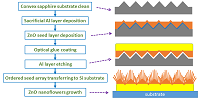Hydrothermally Grown ZnO Nanoflowers on a Template-Assisted Ordered Seed Array
Keywords:
zinc oxide, nanoflower, template-assisted, lift-off, hydrothermal, sol-gelAbstract
1-D nanostructure arrays recently attract much attention because of their unique optical, structural, and electronic properties in the field of materials science, microelectronics, and optoelectronic engineering. Zinc Oxide (ZnO) nanoflowers were synthesized by a facile hydrothermal method on a template-assisted deposited ZnO seed array. The ZnO thin film was prepared via a sol-gel spin-coating process on a concave sapphire substrate first. Then an Al layer and an optically clear resin film were individually deposited on the ZnO thin film. After a lift-off process, a convex ZnO seed array film was formed. Finally, ZnO nanoflowers were synthesized by the hydrothermal method at 90oC for 10 to 60 min. The structural, morphological and optical properties of the ZnO nanoflowers were investigated. The XRD results indicate that the ZnO nanoflowers were polycrystalline with a hexagonal wurtzite-type structure with a (002) preferential orientation. The FE-SEM micrographs exhibited the diameter and length of ZnO nanorods increased with the increasing growth time from 10 to 60 min. The 105-nm diameter and 1150-nm length nanorods were obtained with 60-min growth time. Photoluminescence spectra showed a sharp emission peak (IUV) at approximately 380 nm and its intensity increased with the growth time. A weak emission band (IVIS) at 450–550 nm was also observed and the IUV/IVIS increased with the growth time. This result indicates that the defects were reduced and the crystal quality was enhanced with the growth time. The prepared ZnO nanoflowers can be applied to various optoelectronic and sensing devices.
References
Ü. Özgür, Y. I. Alivov, C. Liu, A. Teke, M. A. Reshchikov, S. Doğan, V. Avrutin, S. J. Cho, and H. Morkoç, “A comprehensive review of ZnO materials and devices,” Journal of Applied Physics, vol. 98, 041301(1-103), 2005.
A. B. Djurisic and Y. H. Leung, “Optical properties of ZnO nanostructures,” Small, vol. 2, pp. 944-961, 2006.
V. A. Coleman and C. Jagadish, “Zinc oxide bulk, thin films, and nanostructures: processing, properties and applications,” 1st ed. Oxford: Elsevier, pp. 1-20, 2006.
Y. Song, F. Chen, Y. Zhang, S. Zhang, F. Liu, P. Sun, X. Yan, and G. Lu, “Fabrication of highly sensitive and selective room-temperature nitrogen dioxide sensors based on the ZnO nanoflowers,” Sensors and Actuators B: Chemical, vol. 287, pp. 191-198, May 2019.
D. Acharyya, “Influence of rGO cladding in improving the sensitivity and selectivity of ZnO nanoflowers-based alcohol sensor,” IEEE Sensors Journal, vol. 18, pp. 1820-1827, March 2018.
F. H. Wang and C. E. Tsai, “ZnO nanorod-based ultraviolet photodetector prepared on patterned sapphire substrates,” IEEE Journal of Selected Topics in Quantum Electronics, vol. 23, no. 2, p. 3800606, April 2017.
F. H. Wang and C. L. Chang, “Effect of substrate temperature on transparent conducting Al and Fco-doped ZnO thin films prepared by rf magnetron sputtering,” Applied Surface Science, vol. 370, pp. 83-91, 2016.
P. Shende, P. Kasture, and R. S. Gaud, “Nanoflowers: the future trend of nanotechnology for multi-applications,” Artificial Cells, Nanomedicine, and Biotechnology, vol. 46, no. S1, pp. S413-S422, January 2018.
H. Zhang, D. Yang, X. Ma, Y. Ji, J. Xu, and D. Que, “Synthesis of flower-like ZnO nanostructures by an organic-free hydrothermal process,” Nanotechnology, vol. 15, pp. 622-626, March 2004.
Q. Liang, F. Qiao, X. Cui, and X. Hou, “Controlling the morphology of ZnO structures via low temperature hydrothermal method and their optoelectronic application,” Materials Science in Semiconductor Processing, vol. 89, pp. 154-160, 2019
R. Shi, P. Yang, X. Dong, Q. Ma, and A. Zhang, “Growth of flower-like ZnO on ZnO nanorod arrays created on zinc substrate through low-temperature hydrothermal synthesis,” Applied Surface Science, vol. 264, pp. 162-170, 2013.
Q. Li, J. Bian, J. Sun, J. Wang, Y. Luo, K. Sun, and D. Yu, “Controllable growth of well-aligned ZnO nanorod arrays by low-temperature wet chemical bath deposition method,” Applied Surface Science, vol. 256, pp. 1698-1702, 2010.
B. Lin, Z. Fu, Y. Jia, and G. Liao “Defect photoluminescence of undoping ZnO films and its dependence on annealing conditions”, Journal of the Electrochemical Society, vol. 148, pp. G110-G113, 2001.

Published
How to Cite
Issue
Section
License
Submission of a manuscript implies: that the work described has not been published before that it is not under consideration for publication elsewhere; that if and when the manuscript is accepted for publication. Authors can retain copyright of their article with no restrictions. Also, author can post the final, peer-reviewed manuscript version (postprint) to any repository or website.

Since Oct. 01, 2015, PETI will publish new articles with Creative Commons Attribution Non-Commercial License, under The Creative Commons Attribution Non-Commercial 4.0 International (CC BY-NC 4.0) License.
The Creative Commons Attribution Non-Commercial (CC-BY-NC) License permits use, distribution and reproduction in any medium, provided the original work is properly cited and is not used for commercial purposes



